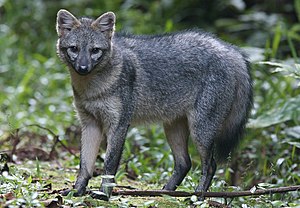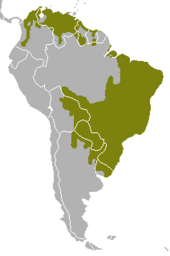Maikong
| Maikong | ||||||||||||
|---|---|---|---|---|---|---|---|---|---|---|---|---|

Maikong ( Cerdocyon thous ) |
||||||||||||
| Systematics | ||||||||||||
|
||||||||||||
| Scientific name of the genus | ||||||||||||
| Cerdocyon | ||||||||||||
| CH Smith , 1839 | ||||||||||||
| Scientific name of the species | ||||||||||||
| Cerdocyon thous | ||||||||||||
| ( Linnaeus , 1766) |
The Maikong ( Cerdocyon thous ) also crab fox is the most common wild dog in South America . It is distributed over large parts of South America east of the Andes and north of Patagonia .
features
In shape and size, the Maikong resembles most other foxes. It has a head-trunk length of 70 to 75 cm, and a tail of almost 30 cm . Its fur is gray-brown on the top and white on the underside. It sometimes has a reddish tinge on the face and legs. The tips of the ears and tail are black. The tooth formula is 3 / 3-1 / 1-4 / 4-3 / 3 = 44.
distribution and habitat
The Maikong has conquered different habitats. It can be found in savannahs, prairies, in the chaco and thorn bush lands, in sparse and closed stands of trees as well as the forests of the subtropics, in transitional forests, the araucarias and mountain rainforests: the distribution area of the Maikong extends from the coastal and mountain regions of the northern part Colombia and Venezuela to Guyana , Suriname and French Guiana . The occurrences in French Guiana have not yet been scientifically verified, while only a few sightings are known from Guyana and Suriname. Another area, separated from the first, extends from the coastal forests on the Atlantic Ocean in Brazil to the eastern Andes in Bolivia , to the south via Paraguay to the province of Entre Ríos in Argentina and to Uruguay . In the Amazonian lowlands, its distribution area is limited to the areas northeast of the Amazon and the Rio Negro , southeast of the Amazon and Rio Araguaia and south of the Río Beni in Bolivia.
Way of life
The English name of this fox, crab-eating fox , suggests a diet of the mayong of crabs. In fact, some maikongs have been observed in Paraguay's wetlands that specialize in such foods, but it is not typical of the species. As an omnivorous canid, mice, birds, lizards, frogs, fish and insects, as well as vegetable foods such as fruits and berries are on its menu.
Maikongs are active at night and at dusk. They live in monogamous couples. Your litter will consist of three to six puppies that will be looked after by both partners. The wearing time is between 52 and 59 days. The puppies reach sexual maturity at the age of 9 months. In the field, litters are observed once a year. Adults have low roaming areas ranging from 0.6 to 0.9 square kilometers.
Systematics
|
Phylogenetic system of South American dogs according to Lindblad-Toh et al. 2005
|
The Maikong is the only species of the monotypical genus Cerdocyon within the dogs. The first scientific description was in 1766 by Carl von Linné as Canis thous , he classified it accordingly in the genus Canis .
As part of the presentation of the genome sequence of the domestic dog , Lindblad-Toh et al. 2005 published a phylogenetic analysis of dogs (Canidae). In the context of this presentation, the Maikong was identified as a sister species of the genus Lycalopex on the basis of molecular biological data . The short-eared fox ( Atelocynus microtis ), which is also native to South America , was shown as a sister species of this group; other species of the clade are the forest dog ( Speothos venaticus ) and the maned wolf ( Chrysocyon brachyurus ).
Today 5 subspecies are officially recognized:
- Ctthous
- Ctazarea
- Ctentrerianos
- Ctaquila
- Ctgermanus
Threat and protection
CITES Appendix 2 contains the crab fox. In Argentina, the species was included in the Red List in 2002 as potentially vulnerable (possibly endangered), as is the case in Colombia. The species is classified by the International Union for Conservation of Nature and Natural Resources (IUCN) as not endangered (least concern) due to the population size and the large distribution area in other countries. The Maikong is relatively common within its distribution areas and is characterized by an opportunistic way of life.
supporting documents
- ↑ a b c d e Lucia Soler: Wild dogs . Ed .: Udo Gansloßer, Claudio Silleo-Zubiri. tape . Filander Verlag, 2006, ISBN 3-930831-63-5 , Der Krabbenfuchs, p. 131 ff .
- ↑ a b c Cerdocyon thous in the endangered Red List species the IUCN 2011. Posted by: O. Courtenay, L. Maffei, 2008. Accessed May 29, 2012 found.
- ↑ a b Kerstin Lindblad-Toh et al .: Genome sequence, comparative analysis and haplotype structure of the domestic dog. Nature 438, December 2005; Page 803–819. ( Abstract ).
- ↑ Don E. Wilson & DeeAnn M. Reeder (eds.): Cerdocyon in Mammal Species of the World. A Taxonomic and Geographic Reference (3rd ed).
- ^ Annalisa Berta: Cerdocyon thous . In: Mammalian Species . tape 186 , 1982, pp. 1–4 ( full text (PDF; 372 kB)). Full text ( Memento of the original from March 4, 2016 in the Internet Archive ) Info: The archive link was inserted automatically and has not yet been checked. Please check the original and archive link according to the instructions and then remove this notice.
literature
- Annalisa Berta: Cerdocyon thous . In: Mammalian Species . tape 186 , 1982, pp. 1–4 ( full text (PDF; 372 kB)).
Web links
- Cerdocyon thous in the endangered Red List species the IUCN 2011. Posted by: O. Courtenay, L. Maffei, 2008. Accessed May 29, 2012 found.

